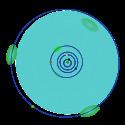Discovery date 20 June 1990 Alternative names 1990 MB Observation arc 13267 days (36.32 yr) Discovered 20 June 1990 | Pronunciation /jʊˈriːkə/ Minor planet category Martian L5 Orbital period 687 days Orbits Sun | |
 | ||
Discoverers Henry E. Holt, David H. Levy Similar 2007 WD5, Solar System, 588 Achilles, 4769 Castalia, 2101 Adonis | ||
5261 Eureka is the first Mars trojan discovered. It was discovered by David H. Levy and Henry Holt at Palomar Observatory on June 20, 1990 from the Palomar Observatory. It trails Mars (at the L5 point) at a distance varying by only 0.3 AU during each revolution (with a secular trend superimposed, changing the distance from 1.5–1.8 AU around 1850 to 1.3–1.6 AU around 2400). Minimum distances from the Earth, Venus, and Jupiter, are 0.5, 0.8, and 3.5 AU, respectively.
Long-term numerical integration shows that the orbit is stable. Kimmo A. Innanen and Seppo Mikkola note that "contrary to intuition, there is clear empirical evidence for the stability of motion around the L4 and L5 points of all the terrestrial planets over a timeframe of several million years".
Since the discovery of 5261 Eureka, the Minor Planet Center has recognized three other asteroids as Martian trojans: 1999 UJ7 at the L4 point, 1998 VF31 at the L5 point, and 2007 NS2, also at the L5 point. At least five other asteroids in near-1:1 resonances with Mars have been discovered, but they do not exhibit trojan behavior. They are 2001 FR127, 2001 FG24, (36017) 1999 ND43, 1998 QH56 and (152704) 1998 SD4.
The infrared spectrum for 5261 Eureka is typical for an A-type asteroid, but the visual spectrum is consistent with an evolved form of achondrite called an angrite. A-class asteroids are tinted red in hue, with a moderate albedo. The asteroid is located deep within a stable Lagrangian zone of Mars, which is considered indicative of a primordial origin—meaning the asteroid has most likely been in this orbit for much of the history of the Solar System.
Satellite
On November 28, 2011, a natural satellite of 5261 Eureka was found. It has yet to be named, and its provisional designation is S/2011 (5261) 1. The moon is about 0.46 km in diameter and orbits 2.1 km from Eureka. The satellite's existence was announced in September 2014.
